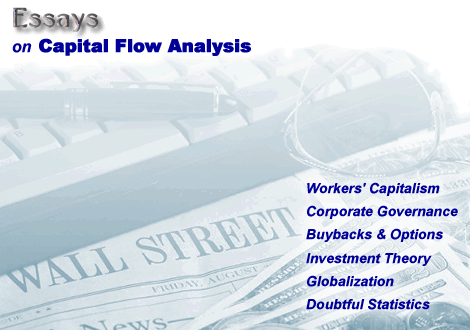Investment Theory: Essays on Capital Flow Analysis
Using Federal Reserve Flow of Funds Accounts to Predict Market Trends

Investment Theory: Essays on Capital Flow Analysis
There are many books on securities markets, mostly about investment techniques and market institutions.
There are fewer sources that deal directly with the flows of funds and customs that actually move the market.
Here are 24 essays that describe long-term forces that have shaped the U.S. stock market in the 1990s and that are likely to continue to be relevant into the 21st century.
These essays are in six categories:
- Workers' Capitalism: Changes in American society have effected capital markets and the outlook for investors.
- Corporate Governance: Who runs American corporations and what are their motives?
- Buybacks and Stock Options: Practices that have distorted U.S. equity markets for a generation.
- Investment Theory: Perceptions of value that effect price trends.
- Globalization: Weakening national borders change capital markets.
- Doubtful Statistics: How far can we trust government economists?

Workers' Capitalism |
|
The World Turned Upside DownIn the last generation, net cash flows into stocks have reversed course. On balance, capital now flows from corporations to investors, rather than in the direction most Americans imagine. During the Great Bubble, Wall Street played a bigger role in raising capital for foreign markets than for the United States, helping to send jobs abroad. |
|
Capitalism EvolvesOver many generations, American society has evolved from a nation of self-employed entrepreneurs to a country of hired workers. Immigration and the closing of the frontier have been decisive in this shift. An excess of workers of diverse national origins has fostered secular universities, which now promote doctrines of moral relativism. |
|
FDR and Workers' CapitalismDuring the 1930s, Franklin Roosevelt effected changes in the American economy and political structure that have contributed to the shortage of equities in the 1990s and the decline in corporate ethics. FDR's policies did not get the country out of the Depression, and his failures have been hidden from most Americans. |
|
Migrant MotherMuch of what passes for history is just propaganda of some long-dead demagogue. Here is a story of 'three little people ... in this crazy world'' that helped to spin the legend of the New Deal that continues to influence U.S. politics in the new millennium. |
|
Corporate Governance |
|
Corporate MotivationWhat do corporations want? The answer depends upon who is in charge, the times, and the country. Over the last half of the 20th century, increased power of professional managers elected by institutional investors has led to emphasis on short-term stock prices and less concern for long-term investors and the national well-being. |
|
Corporate GovernanceThe great buzzword of the 1990s and beyond, corporate governance, represents a world-wide effort to deal with problems caused by conflicting interests of professional managers, institutional investors, and the ultimate owners of corporations. So far, touchy-feely codes of ethics and phony fixes, like independent directors, have done little to resolve the issues. |
|
The Primary StakeholderGovernment, not management or investors, is the primary and ultimate stakeholder in corporate affairs, and is ultimately responsible for how corporations, as a group, act. This essay describes how the motivation of government has evolved, forcing changes in corporate behavior. |
|
MBAs and EthicsIf we are to solve the problem of corporate governance, we should start by looking at business schools that teach ethical ambiguity. This essay explores the famous Harvard Business School 'case method' and questions its relevance to moral behavior and truly educated leaders. |
|
The Agency ProblemThe crisis in corporate governance in the U.S. capital market will take more than independent directors to resolve. There is a fundamental agency problem that is the result of workers' capitalism. There is a fiduciary gap between beneficial owners and hired managers. |
|
Buybacks and Stock Options |
|
Stock Buybacks: A FableHere is a simple tale about the basics of stock buybacks and why company executives have been able to perpetrate one of the greatest rip-offs of the century and fool so many for so long. |
|
The Great MisleadingThe Great Bubble of the 1990s was driven by stock buybacks to the benefit of corporate managers and disadvantage of long-term investors. This unethical practice was widely supported by Wall Street, the SEC, and institutional investors. This article explores the fallacies in the arguments in favor of buybacks. |
|
The Boeing BuybackIn 1998-2001, the Boeing Company engaged in a colossal $9 billion buyback of its own stock, taking 25% of company equities off the market in order to boost stock prices and improve financial ratios. This is a classic example of the asset-lite philosophy that provided reasons for the decapitalization of American industry in the last generation. |
|
Investment Theory |
|
Fallacies of the Nobel GodsThe Great Bubble of the 1990s was sustained by favorable economic theories, many of which were advanced by Nobel laureates. Markowitz, Miller, Modigliani, Sharpe, Scholes, Merton and others provided Wall Street with justification for risky investment behavior. |
|
Uncontrollable RiskThe collapse of Long Term Capital Management raises questions about the role of banks as insurers of interest and exchange rates and the safety of banks as traders in the derivative markets. Interest and exchange rate risk is not subject to effective diversification, making insurers vulnerable. |
|
The Value of DividendsFor over one hundred years, common stock investors have loved dividends. In the latter half of the 20th century, investor expectations changed. Here is the story of how dividends were used to value common stocks and why investors are poorly served by modern theories of value. |
|
The Hidden ShortageBehind the Great Bubble of the 1990s was a shortage of equities that went largely unreported in the press and unnoticed by Wall Street. There are reasons why this shortage was hidden, including the way stocks are quoted, economic theory, and investors' lack of knowledge about the intrinsic value of their holdings. |
|
Mr. Clendenin's SuggestionIn 1957, John Clendenin suggested an improvement to John Burr Williams' equations on discounted cash flow of dividends of common stock. It seemed to him that a higher discount rate should be applied to more distant segments of the dividend stream. His observations are important in understanding the over-valuation of equities in the 1990s. |
|
The Three Faces of ValuePlayers in equity markets have three distinctly different expectations with regards to issuers of common stock. Price levels depend upon which of these players comes to dominate the market. |
|
Globalization |
|
Globalization and Capital FlowsIn a global economy, no capital market is an island unto itself. Not only does money and ownership of assets move easily across borders, but there is a convergence of capital market institutions and customs, helped along by an informal global government. |
|
Terror and Capital MarketsWar is the greatest exogenous variable in investment decisions and the War on Terror is no exception. Atomic weapons in the hands of suicide bombers may effect world history in ways no one can predict. |
|
Doubtful Statistics |
|
The Truth about the GDPMany people think that increasing the Gross Domestic Product (GDP) is a good thing. In Clinton-speak of the 1990s this was called growing the economy. However, a larger GDP does not mean a happier nation. This article points to the shortcomings of using GDP as a performance goal for national policy. |
|
Productivity Flim-FlamOne of the measures of economic performance during the 1990s has been the much-vaunted concept of constantly increasing productivity. However, not many people know how productivity is measured in a service economy, or why increasing these numbers is necessarily a sign of progress. |
|
Fiddling the CPIIn a world of fiat money, a reliable index to measure inflation is important. However, under President Clinton, a blue ribbon panel of economists recommended measures to understate the Consumer Price Index that will color the reliability of government reports on inflation for years to come. |
|
Population and ProfitsThe long-term force behind the growth of corporate profits has been demographic expansion. During the Great Bubble of the 1990s, expectations regarding the growth of earnings were not based on commonsense. |
|























